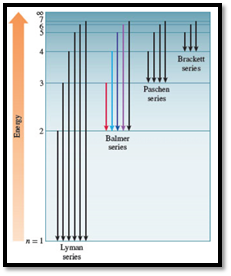
Interpretation:
The inadequacies of Bohr’s theory should be explained using the concept of Bohr’s theory.
Concept Introduction:
The emission of radiation given by an energized hydrogen atom to the electron falling from a higher-energy orbit to a lower orbit give a quantum of energy in the form of light. Based on electrostatic interaction and law of motion, Bohr derived the following equation.
where
The electrons are excited thermally when the light is used by an object. As a result, an emission spectrum comes. Line spectra consist of light only at specific, discrete wavelengths. In emission, the electron returns to a lower energy state from
This transition results in the photon’s emission with frequency
When
Bohr’s theory of the hydrogen atom describes an atom as a small, positively charged nucleus with electrons travelling around it in circular orbits. It explains the appearance of an emission spectrum because the “orbits” available for the electrons to occupy in their excited states are quantized. The resulting transition emits a specific wavelength of light because the energy of the “orbit” is quantized.

Figure.1
Visible line emission spectrum of hydrogen
The emission spectrum of hydrogen shows a wide range of wavelengths from the infrared to the ultraviolet region. The given table lists the series of transitions in the hydrogen spectrum, each with a different value of
| Series | Spectrum region | ||
| Lyman | 1 | 2, 3, 4, ... | Ultraviolet |
| Balmer | 2 | 3, 4, 5, ... | Visible and Ultraviolet |
| Paschen | 3 | 4, 5, 6, ... | Infrared |
| Brackett | 4 | 5, 6, 7, ... | Infrared |
The given figure shows transitions associated with spectral lines in each of the emission series. Each horizontal line represents one of the allowed energy levels for the electron in a hydrogen atom. The energy levels are labeled with their

Figure.2
Energy levels in the hydrogen atom and the various emission series.
Each series ends at a different value of
Want to see the full answer?
Check out a sample textbook solution
Chapter 7 Solutions
General Chemistry
 ChemistryChemistryISBN:9781305957404Author:Steven S. Zumdahl, Susan A. Zumdahl, Donald J. DeCostePublisher:Cengage Learning
ChemistryChemistryISBN:9781305957404Author:Steven S. Zumdahl, Susan A. Zumdahl, Donald J. DeCostePublisher:Cengage Learning ChemistryChemistryISBN:9781259911156Author:Raymond Chang Dr., Jason Overby ProfessorPublisher:McGraw-Hill Education
ChemistryChemistryISBN:9781259911156Author:Raymond Chang Dr., Jason Overby ProfessorPublisher:McGraw-Hill Education Principles of Instrumental AnalysisChemistryISBN:9781305577213Author:Douglas A. Skoog, F. James Holler, Stanley R. CrouchPublisher:Cengage Learning
Principles of Instrumental AnalysisChemistryISBN:9781305577213Author:Douglas A. Skoog, F. James Holler, Stanley R. CrouchPublisher:Cengage Learning Organic ChemistryChemistryISBN:9780078021558Author:Janice Gorzynski Smith Dr.Publisher:McGraw-Hill Education
Organic ChemistryChemistryISBN:9780078021558Author:Janice Gorzynski Smith Dr.Publisher:McGraw-Hill Education Chemistry: Principles and ReactionsChemistryISBN:9781305079373Author:William L. Masterton, Cecile N. HurleyPublisher:Cengage Learning
Chemistry: Principles and ReactionsChemistryISBN:9781305079373Author:William L. Masterton, Cecile N. HurleyPublisher:Cengage Learning Elementary Principles of Chemical Processes, Bind...ChemistryISBN:9781118431221Author:Richard M. Felder, Ronald W. Rousseau, Lisa G. BullardPublisher:WILEY
Elementary Principles of Chemical Processes, Bind...ChemistryISBN:9781118431221Author:Richard M. Felder, Ronald W. Rousseau, Lisa G. BullardPublisher:WILEY





